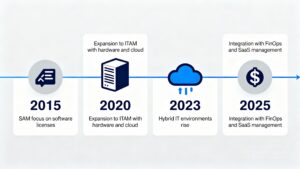Software license costs are driving IT budgets in mid-size and large companies today. Especially with complex products from vendors like Microsoft, SAP, Oracle, IBM, ServiceNow, Salesforce and Adobe, demands on license management are increasing and so are the potential savings for buyers, IT decision-makers, and other stakeholders.
Why License Compliance Matters for Enterprises
Lack of transparency in license management can result in significant extra costs and business risks. Software vendors use diverse license models and offer various tools and contracts – from subscriptions (Microsoft 365, Adobe Creative Cloud) to consumption-based licenses (Oracle, SAP). Losing track risks not only compliance but also profitability.
Typical Challenges in License and Cost Management
- Complex license models and contract structures (Microsoft, Oracle, IBM).
- Frequent vendor audits (SAP, Adobe, ServiceNow).
- Redundant applications increase costs and complicate monitoring.
- Unclear responsibilities between SAM, IT, FinOps, purchasing, and finance.
How to Save Costs and Ensure Compliance
Software solutions for license management create the required transparency. Tools such as Flexera, Snow Software, USU, Xensam, Matrix42 or ServiceNow offer centralized platforms for monitoring and optimizing license data. Consolidating applications, negotiating contracts, and regularly reviewing actual usage can unlock savings.
Best practices include:
- Normalizing and updating software asset and license data regularly.
- Conduct regular license compliance calculations.
- Use software asset management (SAM) tools.
- Monitor usage to reclaim unused licenses.
- Removing unnecessary or duplicate applications promptly.
- Defining shared responsibility for all stakeholders. Train procurement and IT teams on vendor terms.
- Critically reviewing and renegotiating vendor and contract offers.
Major Software Vendors and Their Special Features
| Vendor | Typical License Models | Compliance Risks | Savings Potential |
|---|---|---|---|
| Microsoft | Volume licenses, Azure subscriptions, per-user, per-device, per core, CAL | True-ups, over-licensing, cloud consumption | Contract optimization |
| SAP | Named-user, engine-based, module based usage, consumption / document based, indirect access fees | Own audit teams, indirect usage | Usage analysis |
| Oracle | Named User Plus (NUP), Processor-based, Application User, and Employee-based | Licensing on virtual environments, Audit, complex conditions | License bundling |
| Adobe | Creative Cloud per user / consumption based subscriptions | Overusage, user changes | User tracking |
| IBM | Processor Value Unit (PVU), Virtual Processor Core (VPC), Resource Value Unit (RVU), user-based models | Audit, software metrics | Contract flexibility |
Conclusion: Strategic Tools Lower Costs
Organizations that approach license compliance holistically and use modern license management tools save money and reduce the risk of vendor audits and legal disputes. Collaboration among stakeholders and regular monitoring are the keys to success.
Want to take control of your license and software costs?
Use the consulting and resources on my website to find tailor-made solutions. Reach out for a personal audit!



